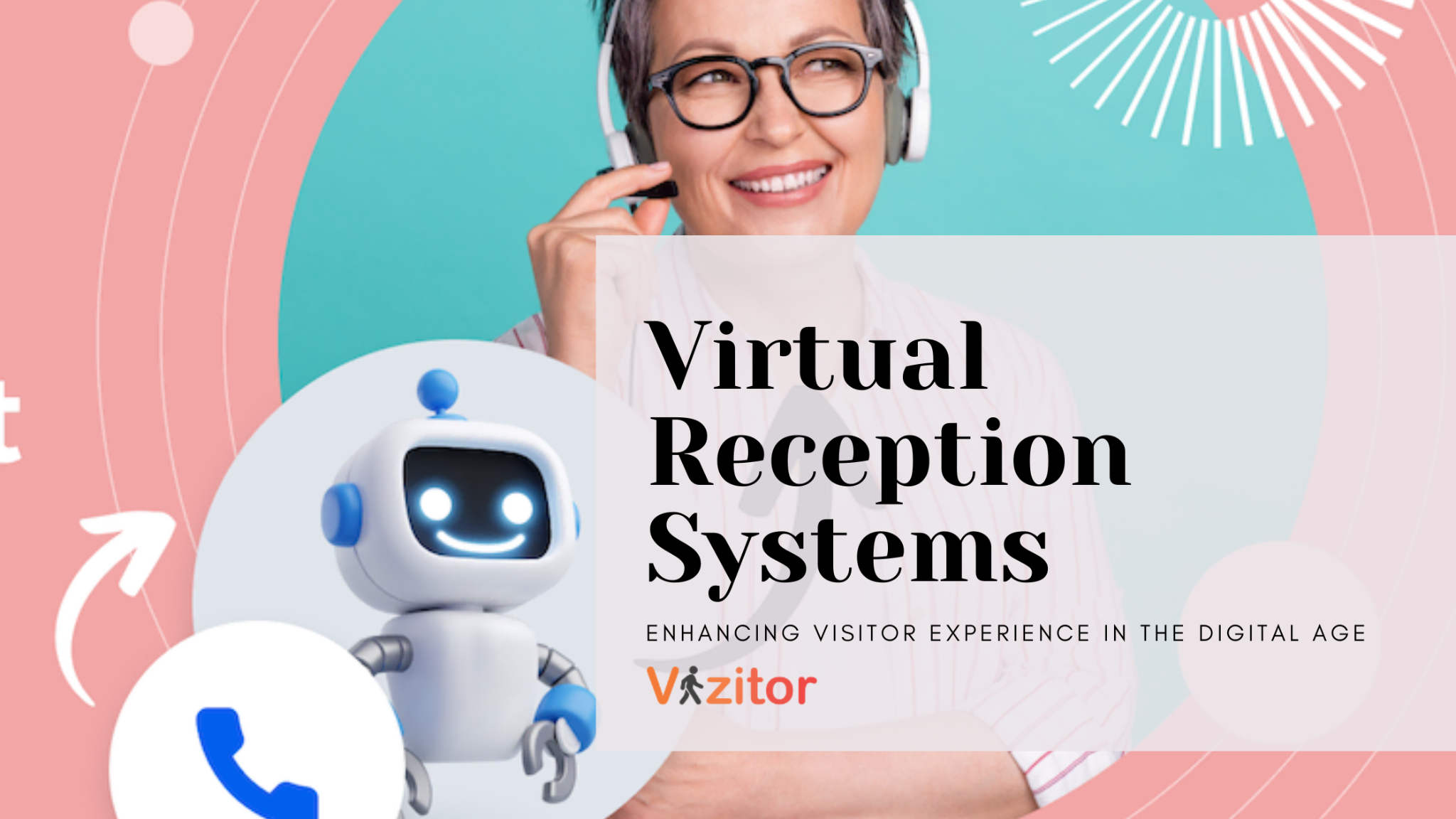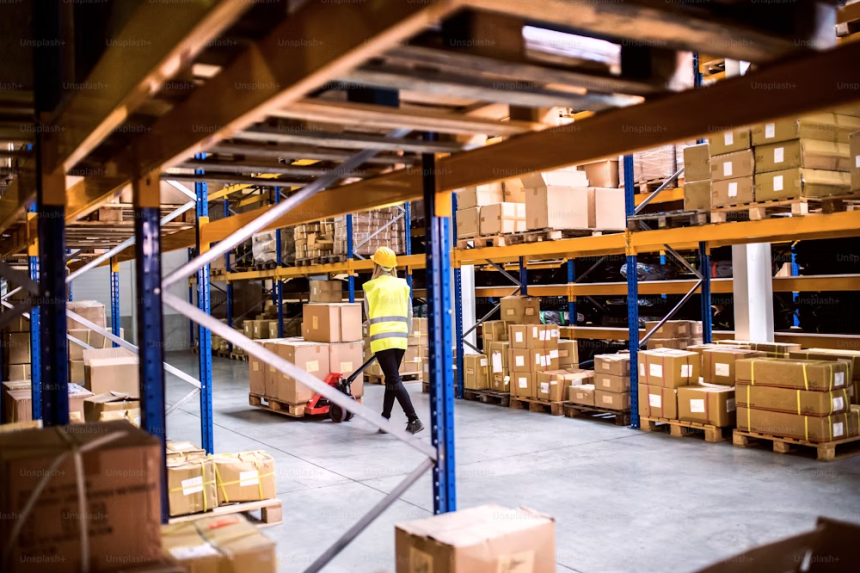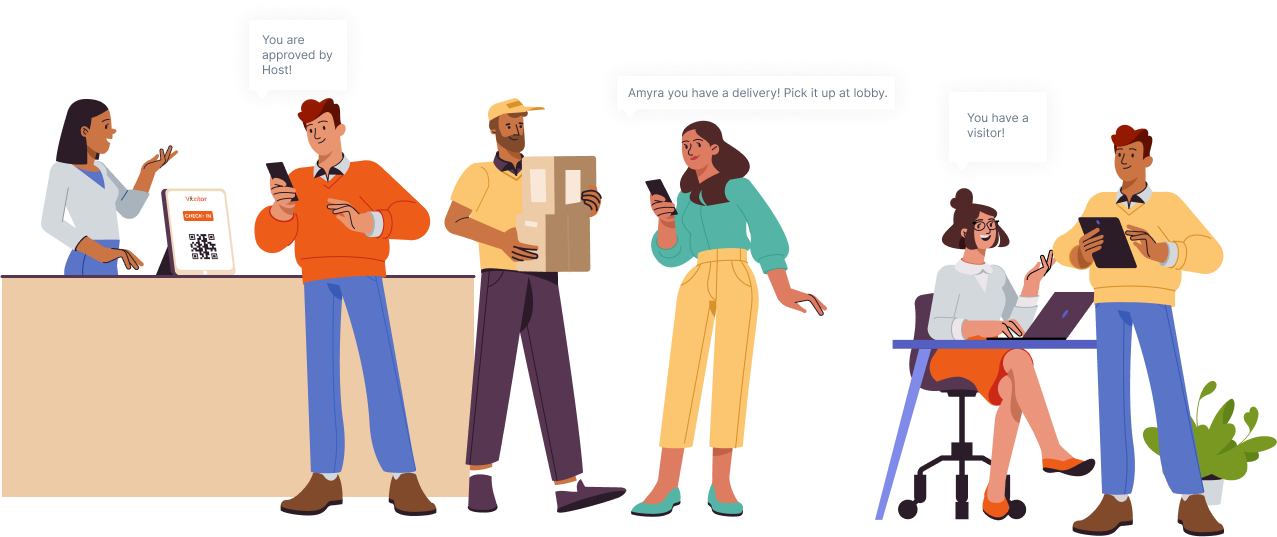Table of Content
Try Vizitor for Free!

Wed, Sep 4, 2024
Read in 12 minutes
Introduction
Did you know that businesses with virtual receptionist solutions report up to 30% more efficient visitor management? Imagine walking into a modern office where, instead of a traditional receptionist, you are greeted by an interactive touchscreen or a friendly virtual assistant. This is not science fiction but a rapidly growing trend transforming how companies manage their front desks.
Virtual front desk receptionist use advanced technology to streamline visitor check-ins, manage appointments, and enhance security. They reduce the need for full-time reception staff, saving costs while providing a seamless and professional experience for visitors. These systems can handle multiple tasks simultaneously, from printing visitor badges to notifying employees of their guest’s arrival, ensuring no one is left waiting.
With features like facial recognition, digital signatures, and real-time data analytics, virtual front desk solutions offer a futuristic approach to office management. They cater to businesses of all sizes, providing scalability and customization to meet specific needs. Embrace the future of digital reception software and discover how these innovative solutions can enhance your office efficiency and visitor experience.
The Evolution of Reception Management
Reception management has come a long way from its humble beginnings. Traditionally, reception areas were manned by personnel responsible for greeting visitors, handling mail, managing phone calls, and maintaining appointment schedules. This setup was effective but often led to bottlenecks during peak hours and required significant staffing costs.
In the early days, a receptionist’s role was pivotal in ensuring smooth office operations. They served as the first point of contact, offering a personal touch and managing various administrative tasks. However, as businesses grew and technology advanced, the limitations of traditional reception management became apparent. Manual processes were time-consuming, prone to errors, and lacked scalability.
The introduction of computers and basic digital systems brought some improvements, but the real revolution began with the advent of virtual reception solutions. These modern systems integrate advanced technologies like AI, facial recognition, and cloud-based management tools. Virtual reception solutions automate visitor check-ins, manage appointments, and enhance security measures, all while reducing operational costs.
In conclusion, virtual receptionist solutions have transformed how businesses manage their front desks. By offering efficiency, scalability, and a seamless visitor experience, they have become essential in the contemporary office environment, ensuring businesses remain competitive and professional.
The Rise Of Virtual Front Desk
The concept of the virtual front desk began as a response to the growing need for efficient visitor management and reduced operational costs. Initially popular in tech-savvy industries, this innovative approach has now permeated various sectors, transforming how businesses manage their reception areas.
Virtual front desks utilize advanced technologies such as AI, touchscreens, and cloud-based systems to automate visitor check-ins, manage appointments, and enhance security. These solutions are particularly important in industries like healthcare, corporate offices, and hospitality, where high visitor volumes and stringent security measures are crucial.
For example, a study by Gartner revealed that 65% of companies implementing virtual reception solutions in 2023 reported a 40% increase in operational efficiency. In healthcare, virtual front desks streamline patient check-ins, reducing wait times and enhancing patient experience. A case study at a major hospital showed a 50% decrease in check-in times after adopting a virtual front desk system.
In the corporate world, companies like Google and Microsoft have integrated virtual receptionists to manage visitor flow and ensure seamless operations. A report by Forbes highlighted that businesses using these systems experienced a 30% reduction in reception staffing costs and a 20% increase in visitor satisfaction.
Key Components of a Virtual Reception System
A virtual reception system is a comprehensive solution that combines multiple technologies to streamline visitor management, enhance security, and provide valuable data insights, making it an essential tool for modern businesses.
-
Touchscreen Kiosks: These serve as the primary interface for visitors to check in, providing a user-friendly experience. Visitors can enter their details, select the purpose of their visit, and even print visitor badges.
-
Facial Recognition: This advanced technology enhances security by verifying the identity of visitors. It can quickly match faces with pre-registered profiles, allowing seamless entry for frequent visitors.
-
Digital Sign-In and Sign-Out: Digital logbooks replace traditional paper logs, making the process faster and more accurate. This component tracks visitor movements and ensures data is easily accessible for future reference.
-
Appointment Management: Integrating with calendars and scheduling tools, virtual receptionist System can manage appointments, send reminders, and notify hosts of their visitor’s arrival, streamlining the entire process.
-
Visitor Badge Printing: Automated badge printing allows for quick issuance of visitor IDs, enhancing security and professional appearance. These badges can include photos, visit details, and access permissions.
-
Real-Time Notifications: Hosts receive instant alerts via SMS, email, or app notifications when their visitors arrive, ensuring timely meetings and reducing waiting times.
-
Data Analytics and Reporting: Comprehensive analytics provide insights into visitor trends, peak times, and other metrics, helping businesses optimize their reception management and improve visitor experience.
-
Integration with Security Systems: Integration with access control systems, CCTV, and emergency protocols enhances overall security, ensuring that only authorized individuals can enter specific areas.
-
Cloud-Based Management: Storing data in the cloud ensures it is accessible from anywhere, facilitates easy updates, and offers robust data security and backup.
-
Multilingual Support: Catering to a diverse visitor base, multilingual support ensures that visitors can interact with the system in their preferred language, enhancing user experience.
Benefits of Implementing a Virtual Reception App
Implementing a virtual receptionist app brings numerous benefits, from cost savings and enhanced security to improved visitor experiences and valuable data insights. It is a smart investment for businesses looking to modernize their front desk operations and stay ahead in a competitive market.
Enhanced Efficiency
Virtual reception apps streamline the visitor check-in process, reducing wait times and minimizing manual entry errors. Automated systems handle multiple tasks simultaneously, freeing up staff to focus on more critical activities.
Cost Savings
By reducing the need for full-time reception staff, businesses can save on salary and training expenses. Virtual reception apps offer a cost-effective alternative, especially for small to medium-sized enterprises.
Improved Visitor Experience
With features like touchless check-ins, pre-registration, and instant notifications, visitors enjoy a seamless and professional experience. The app ensures that visitors feel welcomed and informed from the moment they arrive.
Enhanced Security
Virtual reception apps incorporate advanced security measures such as facial recognition, digital signatures, and visitor tracking. These features ensure that only authorized individuals gain access to the premises, enhancing overall security.
Real-Time Notifications
Instant notifications alert hosts when their visitors arrive, reducing waiting times and ensuring timely meetings. This feature helps improve internal communication and coordination.
Data Collection and Analytics
The app collects valuable data on visitor patterns, peak times, and visit durations. Businesses can use this data to optimize their reception management, improve resource allocation, and enhance overall operational efficiency.
Environmentally Friendly
By eliminating the need for paper logbooks and visitor badges, virtual reception apps contribute to a reduction in paper waste. This eco-friendly approach aligns with sustainable business practices.
Scalability
Virtual reception apps are easily scalable to accommodate growing visitor volumes or expanding business locations. The system can be customized to meet the specific needs of any organization, ensuring flexibility and adaptability.
Multilingual Support
Catering to a diverse visitor base, virtual reception apps often offer multilingual support, making it easier for non-native speakers to interact with the system. This feature enhances inclusivity and user satisfaction.
Professional Appearance
A virtual receptionist app presents a modern and tech-savvy image to visitors, reflecting positively on the company’s brand. It demonstrates a commitment to innovation and efficiency.
How To Implement a Virtual Front Desk?
The benefits of a well-implemented virtual front desk include cost savings, improved visitor satisfaction, and valuable data insights, making it a worthwhile investment for any forward-thinking organization.
Assess Your Needs
-
Identify Specific Requirements: Understand what your business needs from a virtual front desk. This could include handling high visitor traffic, providing detailed visitor logs, enhancing security, or integrating with current office management systems.
-
Volume of Visitors: Evaluate the number of visitors you typically receive to determine the capacity your system needs to handle.
-
Security Needs: Consider the level of security required. High-security environments might need advanced features like facial recognition and ID verification.
Select the Right Technology
-
Essential Features: Look for systems offering crucial features such as touchless check-ins, visitor pre-registration, instant notifications to hosts, and comprehensive data analytics.
-
Scalability and Integration: Ensure the system can grow with your business and integrate seamlessly with existing technologies like security systems, email platforms, and scheduling tools.
Plan Your Layout
-
Designate an Area: Choose a strategic location for the virtual front desk kiosk, ensuring it is easily accessible and visible to visitors upon entry.
-
Accessibility: Ensure the kiosk is at a convenient height and location for all visitors, including those with disabilities.
Invest in Hardware
-
Touchscreen Kiosks: These serve as the main interface for visitors to interact with the virtual front desk.
-
Cameras for Facial Recognition: Necessary for advanced security and touchless check-ins.
-
Badge Printers: For creating visitor badges on the spot, improving security and visitor management.
-
Tablets for Notifications: Ensure hosts receive real-time alerts about visitor arrivals.
Customize the Software
-
Tailor Workflows: Configure the virtual reception software to match your business processes, such as specific check-in procedures, visitor categories, and data collection needs.
-
Notification Settings: Set up how and when hosts receive notifications about visitor arrivals.
-
Security Protocols: Define and implement security measures like ID verification and visitor access levels.
Train Your Staff
-
System Use: Ensure staff are proficient in using the new system, including check-in/check-out procedures, troubleshooting, and assisting visitors.
-
Troubleshooting: Train staff to handle common issues and ensure they know who to contact for technical support.
Integrate with Existing Systems
-
Seamless Data Flow: Connect the virtual front desk to your company’s existing security systems, email, and calendar tools to ensure smooth operation and communication.
-
Interoperability: Ensure the new system works well with current infrastructure to avoid disruptions.
Test the System
-
Thorough Testing: Before full deployment, test the system with a small group to identify any issues or areas for improvement.
-
Gather Feedback: Collect feedback from test users to make necessary adjustments.
Go Live
-
Launch Phase: Introduce the system to all users, ensuring there is support available to address any initial hiccups.
-
Monitor Performance: Keep an eye on how the system is functioning and address any issues promptly.
Collect Feedback
-
Continuous Improvement: Regularly gather feedback from both visitors and staff to understand how the system is performing and where it can be improved.
-
Action on Feedback: Use this feedback to make iterative improvements to the system.
Maintain and Update
-
Regular Maintenance: Schedule and perform regular maintenance checks to ensure the hardware and software are functioning optimally.
-
Stay Updated: Keep the system updated with the latest software versions, security patches, and new features to maintain performance and security.
The Future of Virtual Reception
The future of virtual reception is set to be shaped by cutting-edge technologies such as AI-powered assistants, biometric authentication, and augmented reality wayfinding. These innovations promise to enhance security, improve efficiency, and provide a superior visitor experience. As businesses adopt these advanced solutions, the reception area will become more intelligent, secure, and user-friendly, marking a significant leap forward in how we manage visitor interactions and office operations.
1. AI-Powered Assistants
-
Advanced Interactions: AI-powered virtual assistants are set to revolutionize reception areas by providing intelligent, conversational interactions. These assistants can answer visitor queries, schedule appointments, and offer personalized greetings based on visitor data.
-
24/7 Availability: Unlike human staff, AI assistants can operate around the clock, ensuring seamless visitor management even outside regular business hours. This enhances efficiency and visitor satisfaction.
-
Learning and Adaptation: AI systems continuously learn from interactions, improving over time. They can predict visitor needs and provide increasingly accurate and helpful responses.
2. Biometric Authentication
-
Enhanced Security: Biometric authentication, such as fingerprint scanning, facial recognition, and retinal scanning, ensures that only authorized individuals gain access to the premises. This provides a higher level of security compared to traditional methods.
-
Touchless Check-Ins: With biometric systems, visitors can check in without physical contact, reducing the spread of germs—a crucial feature in a post-pandemic world.
-
Speed and Efficiency: Biometric authentication speeds up the check-in process. For example, facial recognition can verify identities in seconds, reducing wait times and enhancing the visitor experience.
3. Augmented Reality Wayfinding
-
Interactive Guidance: Augmented reality (AR) wayfinding helps visitors navigate complex buildings by overlaying digital directions on their smartphone screens. This makes it easy for visitors to find their way without getting lost.
-
Enhanced Visitor Experience: By providing real-time, interactive navigation, AR wayfinding improves the overall visitor experience. It can also offer additional information about the building or events, creating a more engaging experience.
-
Customizable Routes: AR can tailor routes based on visitor preferences or restrictions, such as avoiding stairs for those with mobility issues. This customization ensures that all visitors have a smooth and accessible experience.
Virtual Reception Revolution With Vizitor
In today’s fast-paced business environment, first impressions matter more than ever. Vizitor, a leading virtual receptionist solution, is revolutionizing the way businesses manage their front desks, offering an efficient, secure, and seamless visitor experience.
-
Transforming Visitor Management: Vizitor automates the entire visitor management process. From touchless check-ins to real-time notifications, Electronic Sign in System ensures that visitors are greeted professionally and efficiently. This reduces wait times and eliminates the need for manual logbooks, enhancing overall visitor satisfaction.
-
AI-Powered Assistants: Vizitor incorporates AI-powered virtual assistants that provide personalized greetings, answer visitor queries, and manage appointments. These assistants operate 24/7, ensuring that visitors are always attended to, regardless of the time of day.
-
Biometric Authentication: Security is paramount with Vizitor’s biometric authentication features. Utilizing facial recognition and fingerprint scanning, Vizitor ensures that only authorized individuals gain access to your premises. This not only enhances security but also speeds up the check-in process, providing a seamless experience.
-
Augmented Reality Wayfinding: With Vizitor’s augmented reality (AR) wayfinding, visitors can easily navigate complex office layouts. By using their smartphones, visitors receive real-time, interactive directions, ensuring they reach their destination without hassle. This innovative feature significantly improves the visitor experience and reduces confusion.
-
Data Analytics and Insights: Vizitor offers comprehensive data analytics, providing valuable insights into visitor patterns and peak times. This data helps businesses optimize their operations, improve resource allocation, and enhance security protocols.
-
Cost-Effective and Eco-Friendly: Implementing Vizitor reduces the need for full-time reception staff, leading to significant cost savings. Additionally, by eliminating paper logbooks and visitor badges, Vizitor supports environmentally friendly business practices.
7. Scalable and Customizable: Vizitor is easily scalable, making it suitable for businesses of all sizes. Whether you have a small office or multiple locations, Vizitor can be customized to meet your specific needs, ensuring flexibility and adaptability.









